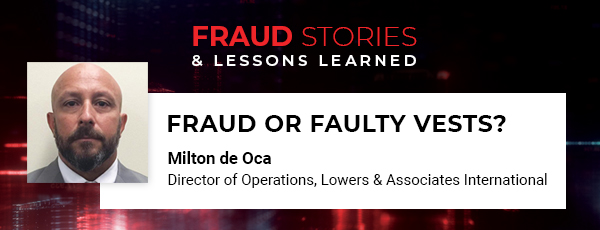Fraud Stories: Fraud or Faulty Vests?

According to the Association of Certified Fraud Examiners (ACFE), a single case of occupational fraud costs the victim organization an average of more than $1.5 million, and Certified Fraud Examiners (CFEs) estimate that organizations lose 5% of their revenues each year to fraud. In the ACFE’s 2020 Report to the Nations, a study of 2,504 cases of occupational fraud investigated by CFEs in 125 countries, the typical fraud lasted 14 months before it was detected and caused a median loss of $8,300 a month.
In an effort to educate organizations on the reality of fraud and to increase awareness of the controls that can help reduce fraud, each year the ACFE sponsors Fraud Awareness Week. Today marks day one of our Fraud Week series, Fraud Stories and Lessons Learned, and we are pleased to introduce Milton de Oca, Director of Operations for Lowers & Associates International. Prior to joining L&A, Milton served 32 years as a police officer with the Miami police department, a gangs sergeant, and finally, as the commander of the intelligence and terrorism unit.
Milton tells the story of an attempted fraud he and the L&A team helped to uncover and resolve in South America related to the procurement of ballistic vests that were to be used for dignitary protection.
Listen to the story here:
This interesting case demonstrates that fraud can come in many forms and at any level. Often it takes a considerable amount of investigation to uncover the fraud and while, in this case, we were able to exonerate the client of the loss, the ACFE reports that most organizations (54%) do not ever recover the losses they suffer at the hand of occupational fraud.
Milton advises all organizations to enlist the help of an independent outside source in cases like these in order to conduct an unbiased investigation.
Stay tuned tomorrow for another fraud story from the front lines of Lowers & Associates.
